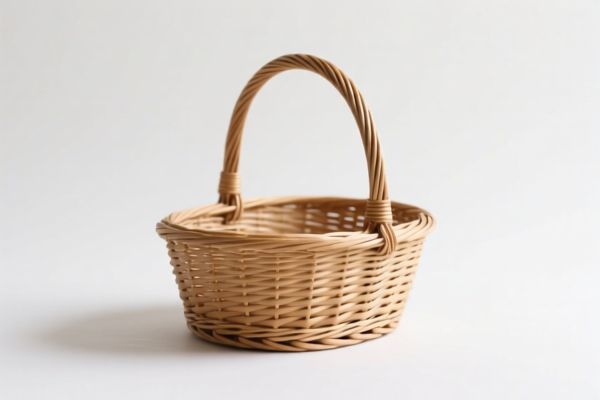| HS Code | Official Doc | Tariff Rate | Origin | Destination | Effective Date |
|---|---|---|---|---|---|
| 4602190500 | Doc | 60.0% | CN | US | 2025-05-12 |
| 4602191200 | Doc | 60.8% | CN | US | 2025-05-12 |
| 4601920500 | Doc | 57.7% | CN | US | 2025-05-12 |
| 4601940500 | Doc | 57.7% | CN | US | 2025-05-12 |




Baskets
Baskets are containers, typically woven or made of rigid material, designed for holding or carrying items. They serve a wide range of purposes, from storage and transportation to decorative displays.
Material
Baskets are constructed from a diverse array of materials, influencing their strength, durability, and aesthetic qualities. Common materials include:
- Natural Fibers:
- Willow: Known for its flexibility and is commonly used for larger, more robust baskets.
- Reed: Lightweight and pliable, often used for decorative or smaller baskets.
- Rattan: A strong, vine-like material, ideal for furniture and sturdy baskets.
- Bamboo: Offers a unique aesthetic and is known for its sustainability.
- Seagrass: Durable and water-resistant, suitable for storage and outdoor use.
- Hyacinth: Provides a textured appearance and is often used for decorative baskets.
- Synthetic Materials:
- Plastic: Lightweight, water-resistant, and affordable, commonly used for laundry baskets and general storage.
- Metal Wire: Offers strength and structural support, often combined with other materials.
Purpose & Function
The function of a basket dictates its design and construction. Common purposes include:
- Storage: Holding household items, toys, clothing, or other belongings.
- Transportation: Carrying groceries, laundry, picnic supplies, or other goods.
- Decoration: Serving as an aesthetic element in home décor.
- Gardening: Collecting produce, holding plants, or organizing garden tools.
- Laundry: Collecting and transporting dirty or clean laundry.
- Picnics & Food: Carrying and presenting food items.
Usage Scenarios
Baskets are utilized in numerous settings:
- Household: Organizing rooms, storing items, and transporting laundry.
- Retail: Displaying products, providing shopping baskets for customers.
- Gardening: Collecting produce, organizing tools, and transporting plants.
- Outdoor Activities: Picnics, camping, and gathering items.
- Events: Gift baskets, decorative displays, and carrying items.
Common Types
- Wicker Baskets: Traditionally made from willow, known for their classic appearance.
- Laundry Baskets: Typically larger, made from plastic or woven materials.
- Picnic Baskets: Often include compartments for food, utensils, and tableware.
- Gift Baskets: Arranged with various items for a specific occasion.
- Hanging Baskets: Used for displaying plants or flowers.
- Storage Baskets: Available in various sizes and shapes for organizing belongings.
- Bread Baskets: Designed for serving bread or other baked goods.
- Market Baskets: Larger, sturdy baskets for carrying groceries or produce.
- Pet Baskets: Designed for pets to rest or travel in.
Baskets encompass a range of articles constructed from woven or plaited materials. The classification depends on the material composition and specific function of the basket.
Here are the relevant HS codes based on the provided information:
- 4602190500: This code covers basketwork, wickerwork, and similar articles made directly from plaiting materials or assembled from articles of heading 4601. Specifically, it applies to articles of vegetable materials, categorized as "Other," and further defined as fishing baskets or creels. The total tax rate is 60.0%, comprising a 5.0% base tariff and a 25.0% additional tariff, increasing to 30% after April 2, 2025.
- 4602191200: This HS code also pertains to basketwork, wickerwork, and similar articles made from plaiting materials or assembled from articles of heading 4601. It applies to articles of vegetable materials, categorized as "Other," and specifically to other baskets and bags, whether or not lined, made of willow. The total tax rate is 60.8%, consisting of a 5.8% base tariff and a 25.0% additional tariff, rising to 30% after April 2, 2025.
- 4601920500: This code covers plaits and similar products of plaiting materials, whether assembled into strips or not, and plaiting materials bound together or woven into sheets. It applies to "Other" vegetable materials, specifically bamboo plaits and similar products. The total tax rate is 57.7%, with a 2.7% base tariff and a 25.0% additional tariff, increasing to 30% after April 2, 2025.
- 4601940500: This HS code covers plaits and similar products of plaiting materials, whether assembled into strips or not, and plaiting materials bound together or woven into sheets. It applies to "Other" vegetable materials, specifically plaits and similar products made from other vegetable materials. The total tax rate is 57.7%, consisting of a 2.7% base tariff and a 25.0% additional tariff, increasing to 30% after April 2, 2025.
Chapter 46: This chapter generally covers articles of vegetable fibers, plaiting materials, straw, esparto or similar materials. Heading 4601: This heading covers plaits and similar products of plaiting materials. Heading 4602: This heading covers basketwork, wickerwork, and similar articles.
Important Note: The applicable tariff rates are subject to change, particularly the additional tariff which will increase to 30% after April 2, 2025. It is crucial to confirm the most up-to-date rates at the time of import.
Customer Reviews
No reviews yet.